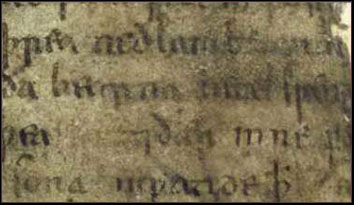There is one manuscript in which Beowulf has survived to the
present day. The earliest known owner of the manuscript is an early
Anglo-Saxon scholar known as Laurence Nowell, Dean of Lichfield. Some
time later, it entered into the manuscript collection of Sir Robert
Bruce Cotton (1571-1631) and was shelved under the bust of Roman
Emperor Aulus Vitellius shelf A, position 15; hence the name Cotton
Vitellius A. xv. It is a composite manuscript consisting of two codices (the Southwick Codex and the Nowell Codex) and nine different works between them. Beowulf follows three prose works in the Nowell Codex and precedes the poem Judith.
| Cotton Vitellius A. xv. |
|---|
The Southwick Codex
1 - The Soliloquia of St. Augustine
2 - The Gospel of Nicodemus
3 - The Debate of Solomon and Saturn
4 - St. Quintin Homily (ending lost)
|
The Nowell Codex
1 - The Life of St. Christopher (beginning lost)
2 - The Wonders of the East
3 - Alexander's Letter to Aristotle
4 - Beowulf
5 - Judith
|
In 1700, Cotton's collection was donated to the British people. By
1722, Cotton's house had deteriorated and the collection was moved to
Essex House in Strand. Seven years later, it was moved again to
Ashburnham House in Westminster. In 1731, Ashburnham House caught
fire. Cotton Vitellius A. xv. was badly burned around the edges when
it was saved by being thrown from the window with many other
manuscripts.
G.J. Thorkelin, an Anglo-Saxonist from Iceland, and a hired scribe
made two transcripts of Beowulf in 1787. It was not until the next century that the British Museum went about systematically repairing the books damaged by the fire. By that time, much of the text of Beowulf had crumbled away from the edges of the pages. By 1845, Cotton Vitellius A.
xv. was rebound mounted on paper frames that help slow the
deterioration of the edges of the pages. In 1882, Julius Zupitza
produced a black-and-white facsimile and transcription of
Beowulf, followed by Kemp Malone's in 1969. In 1990, work on the Electronic Beowulf, a collection of high quality digitizations with
fibre-optic and ultra-violet lighting headed by Kevin Kiernan,
continues at the British Library and the University of Kentucky.
When the 1969 edition of Zupitza's facsimiles went to press, the
manuscript measured 195 mm high by 115-130 mm wide with a written area
175 mm high by 105 mm wide.
On the whole, the manuscript remains fairly readable, but some folios in
particular had seen much neglect. Folio 179/182 is argued to be palimpsest,
that is, it had been erased in preparation for reuse or revision. Here is a
fragment from a preliminary scan from the Electronic Beowulf project:

Fig: Beowulf Manuscript Fragment
This fragment actually corresponds to what appears to be the description of
the dragon. It is possible that we may never know what an Anglo-Saxon
dragon would have looked like.
Some disagreement arises over the foliation, or page numbering, of
Cotton Vitellius A. xv. Evidence shows that this has been attempted at
least six times. At least two attempts were made before the fire of
1731, which have since burned away. The subsequent four attempts can be
found on the outside corners of the manuscript, and on the paper
frames. Two numbering schemes persist as more canonical. The manuscript foliation, performed sometime between 1793 and
1801, was done with two quires of the Nowell Codex out of order, and
two folios of Beowulf out of place. The official foliation
done in 1884 corrects these errors, but becomes somewhat problematic
when converting between the two systems. The following table illustrates them:
1793-1801
Old Foliation |
1884
Official Foliation |
| 129, 130 |
132, 122 |
| 132 to 146 |
134 to 148 |
| 131 |
149 |
| 147 to 188 |
150 to 191 |
| 197 |
192 |
| 189 to 196 |
193 to 200 |
| 198 |
201 |
Cotton Vitelius A. xv. was assembled in gatherings or quires of three
to six vellum leaves tied together with thread. Following the fire
damage and subsequent remounting of the manuscript, it is not longer
possible to be certain which folios went together in quires. While it
is speculated that Cotton Vitellius A. xv. is a collection of
codices, with Beowulf being one of them, one might conclude
that Beowulf might have been a complete work in itself at one
point. However, without knowing the quires that make up the
collection, Beowulf may only be an integral part.
Chase, C. The Dating of Beowulf, University of Toronto Press, 1997.
Kiernan, K.S. Beowulf and the Beowulf Manuscript. Rutgers University Press, 1981.
Thorkelin, G.J. The Thorkelin Transcripts of Beowulf. Malone, K. ed. Early English Manuscripts in Facsimile vol.1, 1951.
Zupitza, J. Beowulf (Facsimile). Oxford University Press, 1959.
